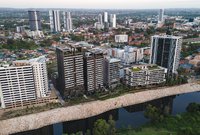PRD Liverpool Property Market Update 1st Half 2024
In Q1 2024, Liverpool recorded a median house price of $1,008,000, and a median unit price of $520,000. This represents an annual (Q1 2023 – Q1 2024) price growth of 5.8% for houses and a minor softening of -1.8% for units. During this time total sales increased, by 13.5% (to 588) sales for houses and by 40.3% (to 355 sales) for units. Confidence has returned to Liverpool, with properties in high demand. Houses in particular suggest real returns on investment, thus an opportunity for owners looking to sell and/or downsize. The unit market is slightly more affordable in Q1 2024, thus an ideal time for first time home buyers to enter the market.
Average vendor discounts between Q1 2023 and Q1 2024 for have tightened to lower discounts, of -1.1% for houses and -4.3% for units. Market conditions in Liverpool still favour buyers, as sellers are willing to accept below initial listing prices. Q1 2024 records the tightest discounts in the past 18 months, especially for houses, thus buyers should act fast to ensure they benefit from this opportunity.
House rental yields in Liverpool was at 3.5%, higher than Liverpool LGA and Sydney Metro (2.9%). This was paired with a 10.8% increase in median house rental price in the past 12 months to Q1 2024, at $720 per week, and a sizable 188.8% growth in the number of houses rented (to 1372 rentals). The unit market shows a similar pattern, which suggests there is a highly demanded rental market overall, is good news for investors.
2-bedroom houses have provided investors with +17.5% rental growth annually, achieving a median rent of $470 per week.
Liverpool recorded a vacancy rate of 0.8% in April 2024, slightly below Sydney Metro’s 1.1% average. Vacancy rates in Liverpool have held relatively steady over the past 12 months, with some minor fluctuations due to investors entering/exiting the market alongside cash rates movements. Further, a 0.8% vacancy rate is significantly below the Real Estate Institute of Australia’s healthy benchmark of 3.0%, which suggests rental properties in Liverpool will be rented quicker. This creates a conducive and sustainable environment for investors.







